 This is Rob Nikolewski, the new Editor of Capitol Report New Mexico; the web site in Santa Fe.
This is Rob Nikolewski, the new Editor of Capitol Report New Mexico; the web site in Santa Fe.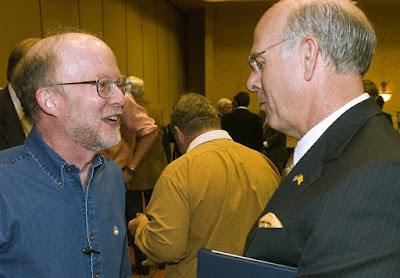 However, don’t confuse it with Capitol Report New Mexico, the blogspot, which is still written by Harold Morgan, above left, interviewing Steve Pierce.
However, don’t confuse it with Capitol Report New Mexico, the blogspot, which is still written by Harold Morgan, above left, interviewing Steve Pierce.I first met Nikolewski at the Legislative interim committee on restructuring state government’s May meetings.
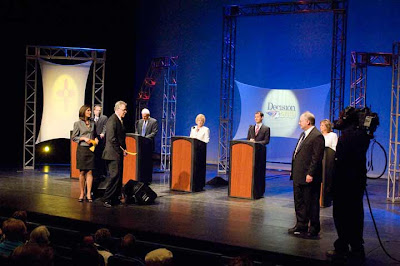 I ran into him again at the KOB Eyewitness News Republican Party’s gubernatorial primary candidates televised debate. He was using a flip camera to record the candidates’ reactions when he ran out of battery power. He turned to me to see if I had a couple of AA batteries I could lend him. For more than 40 years I have made it a policy to give fellow photographers, and journalists, even when they are my competitors, film or digital cards or gadgets or wiring, if I have it in my various camera bags or audio kits to help them out. Over the years this attitude has been reciprocated enough times to make it worthwhile.
I ran into him again at the KOB Eyewitness News Republican Party’s gubernatorial primary candidates televised debate. He was using a flip camera to record the candidates’ reactions when he ran out of battery power. He turned to me to see if I had a couple of AA batteries I could lend him. For more than 40 years I have made it a policy to give fellow photographers, and journalists, even when they are my competitors, film or digital cards or gadgets or wiring, if I have it in my various camera bags or audio kits to help them out. Over the years this attitude has been reciprocated enough times to make it worthwhile.Nikolewski moved to New Mexico from Bucks County Pennsylvania only a few weeks ago.
He wrote to thank me for the use of the batteries and then went on:
Anyway, I just posted a story on my website proposing that the state could save more than $470,000 a year (and possibly much more) by eliminating the Lieutenant Governor’s position. If you’d like to read it the link is (here).So what’s wrong with this picture?
I’d be curious to hear what you think.
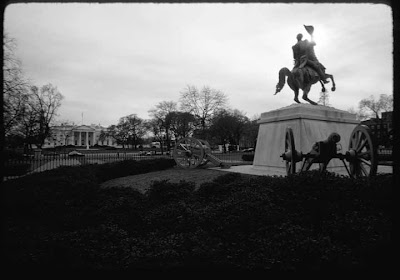 In 1966, when my family moved to New Mexico from the Washington, D.C. area, the politics that I was just becoming aware of, was met with a culture shock in the southwest. My naiveté politically was immense; I was a long way from the Beltway and the Washington Post’s explanations of what I understood to be politics.
In 1966, when my family moved to New Mexico from the Washington, D.C. area, the politics that I was just becoming aware of, was met with a culture shock in the southwest. My naiveté politically was immense; I was a long way from the Beltway and the Washington Post’s explanations of what I understood to be politics.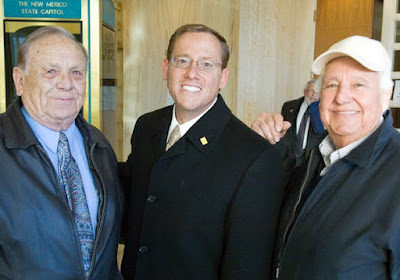 Now, more than 40 years later, I’m not sure how much of my New Mexico political naiveté I’ve shed. Some of my detractors, even some who claim me as a friend say my naiveté politically is still pretty high. Others like now Democratic lt. gov. candidate Brian Colón, above center, told his supporters, Frank Gallegos and Clovis Herrera, that I am the historian of New Mexico politics. I didn’t have the heart to tell him I could lay no further claim than that of only being a visual historian, who has just been around a long time.
Now, more than 40 years later, I’m not sure how much of my New Mexico political naiveté I’ve shed. Some of my detractors, even some who claim me as a friend say my naiveté politically is still pretty high. Others like now Democratic lt. gov. candidate Brian Colón, above center, told his supporters, Frank Gallegos and Clovis Herrera, that I am the historian of New Mexico politics. I didn’t have the heart to tell him I could lay no further claim than that of only being a visual historian, who has just been around a long time.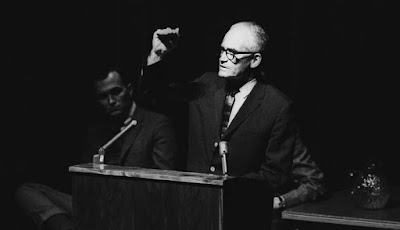 I covered a speech at the University of New Mexico in 1967 by a familiar Washington face, Arizona Republican Senator Barry Goldwater, above, who was defeated in 1964 presidential election by Pres. Lyndon Johnson.
I covered a speech at the University of New Mexico in 1967 by a familiar Washington face, Arizona Republican Senator Barry Goldwater, above, who was defeated in 1964 presidential election by Pres. Lyndon Johnson.My experiences with New Mexico politics truly began during the 1968 Republican Party gubernatorial campaign when Gov. David Cargo was running for his second two-term in office. Cargo’s primary opponent was Clifford J. Hawley of Santa Fe. Cargo was considered a Republican liberal, much like his personal preference for the 1968 GOP Presidential candidate, New York Gov. Nelson Rockefeller.
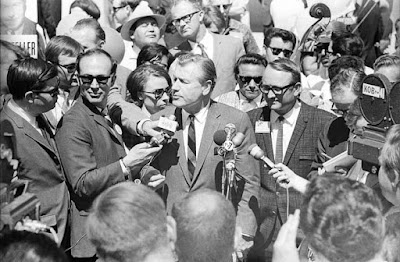 Cargo stood right of Rockefeller during an airport news conference in May 1968 when Rockefeller campaigned in Albuquerque. Rockefeller lost the nomination to Richard Nixon at the GOP convention in Miami.
Cargo stood right of Rockefeller during an airport news conference in May 1968 when Rockefeller campaigned in Albuquerque. Rockefeller lost the nomination to Richard Nixon at the GOP convention in Miami.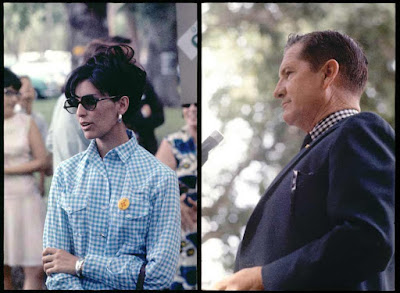 This is Ida Jo Cargo and Hawley at a Memorial Day rally in an Albuquerque city park.
This is Ida Jo Cargo and Hawley at a Memorial Day rally in an Albuquerque city park. The hot dogs were plentiful, while the crowd was sparse.
The hot dogs were plentiful, while the crowd was sparse.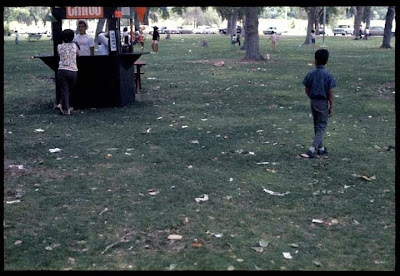 Dave Cargo would allege that while he was on stage giving his stump speech, Hawley insulted his wife with a rude comment. I was standing near Mrs. Cargo and I didn’t hear anything. An insult might have been made; I just didn't notice any commotion.
Dave Cargo would allege that while he was on stage giving his stump speech, Hawley insulted his wife with a rude comment. I was standing near Mrs. Cargo and I didn’t hear anything. An insult might have been made; I just didn't notice any commotion.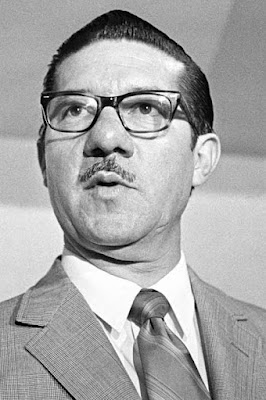 Cargo defeated Hawley for a second time and went on to beat Democratic State Senator Fabian Chavez, Jr., above.
Cargo defeated Hawley for a second time and went on to beat Democratic State Senator Fabian Chavez, Jr., above.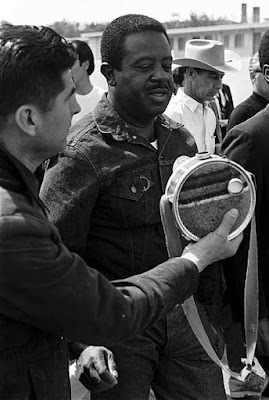 On Saturday May 17, 1968, I covered the Poor People's March through Albuquerque. Local Land Grant activist Reies López Tijerina offers water to the Reverend Ralph Abernathy, right, of the Southern Christen Leadership Conference as they walk near downtown. The Poor People's March ended in Washington, D.C. with the construction of, "Resurrection City."
On Saturday May 17, 1968, I covered the Poor People's March through Albuquerque. Local Land Grant activist Reies López Tijerina offers water to the Reverend Ralph Abernathy, right, of the Southern Christen Leadership Conference as they walk near downtown. The Poor People's March ended in Washington, D.C. with the construction of, "Resurrection City."Tijerina was the founder and head of the Alianza Federal de los Pueblos Libres, translated means, the Alliance of free City States. The Alianza's goals were to restore lands granted by the King of Spain and the Mexican government and protected under the treaty of Guadalupe Hidalgo at the conclusion of the Mexican American War in 1848.
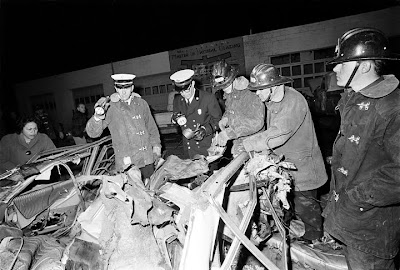 A year later, my coverage of Tijerina expanded by three events: a car bombing, above, at Alianza headquarters, a Spanish language parade celebrating 429 years of Hispanic culture in New Mexico and eight-days of coverage of Tijerina's activities, June 1-8, 1969, culminating in an armed stand off with federal and state law enforcement officers after Tijerina's wife, Patsy, burned two US Forest Service signs, gave me an understanding of street level politics from the inside that few had the opportunity or can comprehend.
A year later, my coverage of Tijerina expanded by three events: a car bombing, above, at Alianza headquarters, a Spanish language parade celebrating 429 years of Hispanic culture in New Mexico and eight-days of coverage of Tijerina's activities, June 1-8, 1969, culminating in an armed stand off with federal and state law enforcement officers after Tijerina's wife, Patsy, burned two US Forest Service signs, gave me an understanding of street level politics from the inside that few had the opportunity or can comprehend.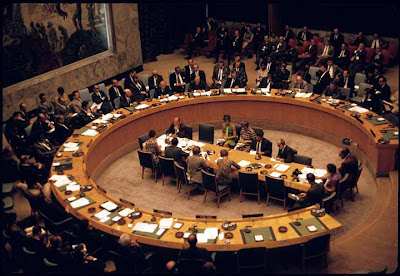 In the mid-summer to late fall of 1969 I was enrolled in the commercial photography course at New York Institute of Photography. I worked on a personal project, a photo essay of the United Nations and made my first foray into international politics.
In the mid-summer to late fall of 1969 I was enrolled in the commercial photography course at New York Institute of Photography. I worked on a personal project, a photo essay of the United Nations and made my first foray into international politics.During the 1970 political season, I was commissioned by Albuquerque News Editor Fred McCaffery, to photograph two campaigns for which he was acting as communications director: Republican candidate for New Mexico Governor Pete Dominci, and Democrat New Mexico United States Senator Joseph P. Montoya’s re-election.
 Former Governor Tom Bolack, above, accompanied Domenici while campaigning and shared his political philosophy, strategy and tactics. Bolack was elected Lt Gov. serving under Edwin Mechem a three-term governor. Mechem lost reelection in 1962 and resigned so that Bolack could appoint him to the US Senate when Democratic Sen. Dionisio "Dennis" Chavez died in office in November 1962. Gov. Bolack served for only 32 days.
Former Governor Tom Bolack, above, accompanied Domenici while campaigning and shared his political philosophy, strategy and tactics. Bolack was elected Lt Gov. serving under Edwin Mechem a three-term governor. Mechem lost reelection in 1962 and resigned so that Bolack could appoint him to the US Senate when Democratic Sen. Dionisio "Dennis" Chavez died in office in November 1962. Gov. Bolack served for only 32 days. Domenici, above left, lost to Bruce King, above right, and Montoya beat Anderson Carter.
Domenici, above left, lost to Bruce King, above right, and Montoya beat Anderson Carter. At the 1970 election night Democratic Party gathering, supporters, above, watch what was then the equivalent of today’s big screen television while one of KOB TV’s managers, Ray Davenport, below, broadcasts early returns from the then Civic Auditorium.
At the 1970 election night Democratic Party gathering, supporters, above, watch what was then the equivalent of today’s big screen television while one of KOB TV’s managers, Ray Davenport, below, broadcasts early returns from the then Civic Auditorium.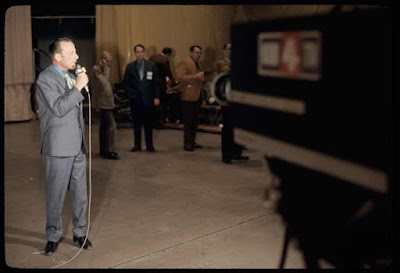
 Roberto A. Mondragon, above celebrating his victory, was elected Lieutenant Governor to serve with Governor-elect Bruce King .
Roberto A. Mondragon, above celebrating his victory, was elected Lieutenant Governor to serve with Governor-elect Bruce King .In 1972, I photographed Republican Bernalillo County District Attorney Alexander F. Scerrese for his re-election. However, Scerrese died of a heart attack during the campaign and Democrat James Brandenburg was elected; he is the father of the current DA, Kari Brandenburg.
 Also in 1972, I experienced the first of a long line of ripped-off photographs for negative political purposes. The New Mexico Democratic Council used a photograph of President Richard Nixon on the cover of a campaign endorsement flier of Democratic candidates for the June primary election for national and state offices. There was a cartoon type balloon over his head which read:
Also in 1972, I experienced the first of a long line of ripped-off photographs for negative political purposes. The New Mexico Democratic Council used a photograph of President Richard Nixon on the cover of a campaign endorsement flier of Democratic candidates for the June primary election for national and state offices. There was a cartoon type balloon over his head which read:"An administration which has four years to end a war and couldn't do it shouldn't have a second chance."I had taken the picture for the Albuquerque News, edited by Mark Acuff, and other photographs of the event were also published in Albuquerque Hard Times edited by Jack Weber. Someone passed the picture along to the Democrats without my permission.
–– Richard M. NixonSanta Monica, Cal.October 1968
Weber told me recently, that he doesn’t specifically recall the incident, but throwing his hands up said, “I’ll plead guilty. Either Acuff or I probably did it.” Acuff, who is now deceased, bought the El Independente newspapers from Filo Sediillo who was the Democratic Party leader at the time, Webber said.
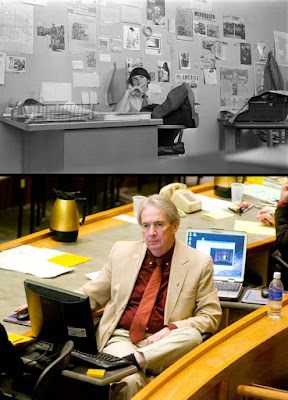 This is Weber, above top, then editing Hard Times and now, below, as the New Mexico House Chief Deputy Clerk preparing for the opening of the Legislature. Acuff and Weber were political pros who were also journalists. However, at the time they couldn't hold a candle to the old pro, Fred McCaffery.
This is Weber, above top, then editing Hard Times and now, below, as the New Mexico House Chief Deputy Clerk preparing for the opening of the Legislature. Acuff and Weber were political pros who were also journalists. However, at the time they couldn't hold a candle to the old pro, Fred McCaffery.In 1973 I moved to the Washington, D.C. area where I did a still photo essay on Domenici's first few weeks as Senator for KOAT TV. I returned to DC and did some Capitol Hill freelancing and then got into law enforcement. My view of national politics broadened.
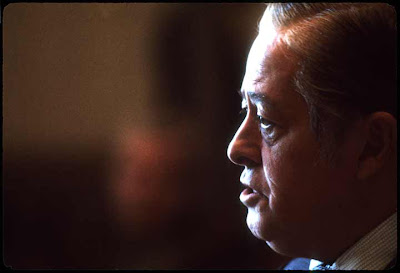 I experienced the Watergate era and attended the testimony of Nixon’s White House Counsel John Dean to the United States Senate’s, “Select Committee on Presidential Campaign Activities,” more commonly referred to as the Senate Watergate Committee. Sen. Montoya, above, sat as the junior Democratic member.
I experienced the Watergate era and attended the testimony of Nixon’s White House Counsel John Dean to the United States Senate’s, “Select Committee on Presidential Campaign Activities,” more commonly referred to as the Senate Watergate Committee. Sen. Montoya, above, sat as the junior Democratic member. I was present at the Committee on the Judiciary of the House of Representatives' impeachment hearings against President Richard Nixon on Saturday July 27, 1974. The committee voted on a second article of impeachment, adopted 28-10, for "repeatedly" failing to carry out his Constitutional oath.
I was present at the Committee on the Judiciary of the House of Representatives' impeachment hearings against President Richard Nixon on Saturday July 27, 1974. The committee voted on a second article of impeachment, adopted 28-10, for "repeatedly" failing to carry out his Constitutional oath.Over the next few days the House Judiciary Committee voted on two more articles of impeachment. Before the committee’s report could come to the full House of Representatives for a vote of four articles of impeachment, left, Nixon resigned and Vice President Gerald Ford became President August 9, 1974.
 The White House fence of the period is illustrative, still standing, but suffering a bend or two.
The White House fence of the period is illustrative, still standing, but suffering a bend or two.
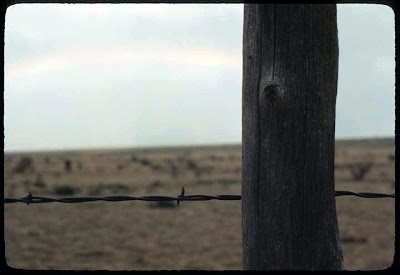 When I returned in the summer of 1976, to join the Albuquerque Police, I saw New Mexico politics in a different light.
When I returned in the summer of 1976, to join the Albuquerque Police, I saw New Mexico politics in a different light.New Mexico is the fifth largest state, at 121,593 square miles. It is the 45th in population density.
According to the US census data the population of New Mexico was: in 1970 just over a million, 1980 – 1.3 million, 1990 – 1.5 million, 2000 – 1.8 million, and currently the population is estimated at just over two million people.
The federal government sends more than two dollars for every tax dollar collected in New Mexico; the highest rate for any state in the country.
The federal government controls almost 42 percent of the land; the ninth largest percentage of individual states; the eight states with larger percentages are all western states.
 What isn't mountainous area is a vast arid landscape, which limits agriculture to river valleys and aquifer fed irrigation areas. Even a little rainfall will bloom up the dessert floor, exploding it with vibrant colors.
What isn't mountainous area is a vast arid landscape, which limits agriculture to river valleys and aquifer fed irrigation areas. Even a little rainfall will bloom up the dessert floor, exploding it with vibrant colors. The lack of a civilian-manufacturing industry base means the military has been the economic cornerstone for the state.
The lack of a civilian-manufacturing industry base means the military has been the economic cornerstone for the state.With clear blue skies and a lot of empty land New Mexico became the testing ground and practice ranges for the Army and Air Force. Los Alamos and Sandia National Laboratories began as part of the World War II Manhattan Project to develop the atom bomb, first tested at what is now White Sands Missile Range.
New Mexico has a long and rich history of a military presence starting with the existence of first nation or aboriginal people, which included warring factions.
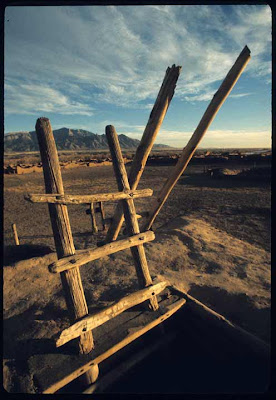 The Spanish conquistadors led by Francisco Vásquez de Coronado y Luján, were looking for El Dorado, Quivira, and the seven cities of Cíbola. Coronado visited a pueblo near what is now Bernalillo, in the winter of 1540-41. In the harsh winter light, adobe, the main construction material of the pueblo, above, appears the color of raw gold and might be the basis of the legendary cities of gold.
The Spanish conquistadors led by Francisco Vásquez de Coronado y Luján, were looking for El Dorado, Quivira, and the seven cities of Cíbola. Coronado visited a pueblo near what is now Bernalillo, in the winter of 1540-41. In the harsh winter light, adobe, the main construction material of the pueblo, above, appears the color of raw gold and might be the basis of the legendary cities of gold.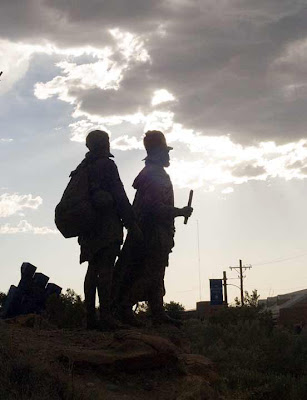 In 1598 Don Juan de Oñate Salazar, sculpture above in Albuquerque, colonized what is now the state.
In 1598 Don Juan de Oñate Salazar, sculpture above in Albuquerque, colonized what is now the state.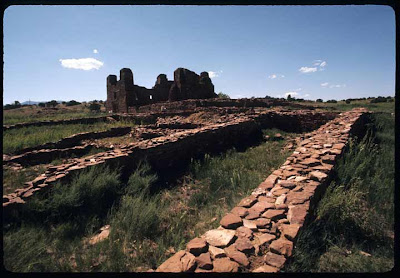 Conquistadors used military might and their religion to dominate the area like Quarai Mission, above, (which is now part of Salinas Pueblo Missions National Monument) until the pueblo revolt of 1680. Twelve years later, the Spaniards returned, less violent and more accepting of the pueblos.
Conquistadors used military might and their religion to dominate the area like Quarai Mission, above, (which is now part of Salinas Pueblo Missions National Monument) until the pueblo revolt of 1680. Twelve years later, the Spaniards returned, less violent and more accepting of the pueblos.After Mexican Independence from Spain, in 1821, there was a minimal governmental presence from the south and it only lasted some 27 years.
The United States took possession after the Mexican-American War of 1846-48, which began with the annexation of Texas into the Union.
Half of what is today New Mexico, east of the Rio Grande, was the western part of the Texas Republic after the 1836 revolution with Mexico; even Santa Fe and Albuquerque were officially Texas.
Upon acquisition from Mexico, the New Mexico territorial boundaries were redrawn and ran from the present day eastern border with Texas westward to California. It included parts of Colorado, Nevada, and most of Arizona, minus the Gadsden Purchase.
Above the New Mexico territory was the Utah territory which ran from about the continental divide in Colorado west to California in what is now most of the states of Utah and Nevada, and also parts of Colorado and Idaho.
The US government had military installations all across the area to protect travelers from murdering tribes, outlaws, and rustlers.
In 1916, Pancho Villa, who has been described as everything from a bandit, to revolutionary, to military general, attacked the small southern town of Columbus, just across the border from Mexico. In the battle, 18 Americans, eight 13th Cavalrymen and 10 civilians were killed.
US President Woodrow Wilson ordered General John J. Pershing to initially lead 4,800 men on the Mexican Expedition to capture Villa. Pershing reportedly considered the 11-month effort a failure.
 Two significant things happened militarily: the first use of airplanes for aerial reconnaissance, and the failure of effective use of cavalry troops as opposed to the use of automotive transportation. The above full size sculptured replica of a Curtiss JN-3 Jenny biplane, one of the 10 airplanes making up the 1st Aero Squadron in Columbus.
Two significant things happened militarily: the first use of airplanes for aerial reconnaissance, and the failure of effective use of cavalry troops as opposed to the use of automotive transportation. The above full size sculptured replica of a Curtiss JN-3 Jenny biplane, one of the 10 airplanes making up the 1st Aero Squadron in Columbus.In more recent times, the state was home of numerous training facilities, air bases and munitions camps.
Current Air Force Bases are: Kirtland, at Albuquerque, Holloman, at Alamagordo, and Cannon, at Clovis. Army facilities includes White Sands Missile Range and much of Fort Bliss Military Range.
 The New Mexico Air Guard has been in operation since after WWII, but is losing its F-16 airplanes and is struggling to maintain an aircraft mission. In the late 1960s the Guard was flying F-100s, above, and the unit served a tour in South Vietnam with a very high mission accomplishment record.
The New Mexico Air Guard has been in operation since after WWII, but is losing its F-16 airplanes and is struggling to maintain an aircraft mission. In the late 1960s the Guard was flying F-100s, above, and the unit served a tour in South Vietnam with a very high mission accomplishment record. New Mexico is an isolated outpost of the country, being admitted as the 47th state in January 1912, only three weeks before Arizona was admitted as the last state in the lower continental North America.
New Mexico is an isolated outpost of the country, being admitted as the 47th state in January 1912, only three weeks before Arizona was admitted as the last state in the lower continental North America.An Arizona Territory was the topic of discussion as far back as 1851. The original proposal was to divide New Mexico, north – south.
During the Civil War the southern portion of the New Mexico Territory was made part of the Confederate States of America. Congress in 1862 redrew the dividing line longitudinally, separating the territories east – west, to deny the Confederate status.
Arizona decided to join the United States on the fiftieth anniversary of the Confederacy's formally making the territory part of the South. The symbolism is not lost today by the acts of the state in its political acts based on race and ethnicity.
Albuquerque grew to become the largest city after the railroad expanded through the state.
Yet, to travel to a comparable sized or larger city, one has to travel to: El Paso, Texas, 270 miles south, Phoenix, Arizona, 426 miles west, Denver, Colorado, 449 miles north, and Oklahoma City, Oklahoma 544 miles east.
With 22 Indian tribes, a large Hispanic population, a relatively small African-American presence and minor numbers for various other people, ethnicities, races, and nationalities, New Mexico has the largest percentage of a minority groups of all states in the country making it the only "minority-majority" state.
The African-American history in New Mexico is punctuated by cowboys and Cavalrymen, termed by Indians, as "Buffalo Soldiers." When you watch John Wayne in old John Ford Westerns of the late 1800s, and the cavalry coming to the rescue in the nick of time; the movie is probably not being historically accurate; more likely those troops were African-Americans led by white officers.
The width and depth of diversity from aboriginal to indigenous people by virtue of the pre-Colombian, Spanish colonization, and later an independent Mexico, created a strong cultural and religious influences on establishing state politics for more than 300 years before a significant migration of anglos.
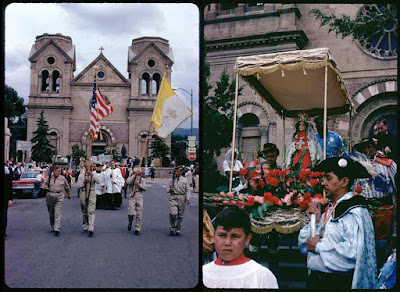 This is a church procession during the Santa Fe Fiesta in 1966 from the Cathedral parading a statue of Mary under armed escort of the city police.
This is a church procession during the Santa Fe Fiesta in 1966 from the Cathedral parading a statue of Mary under armed escort of the city police.With the imposition of the traditional Anglo-Saxon governmental model, territorial rule and statehood came into existence which differed from the form of government associated with the Spanish – Mexican governments.
This differing models haven't always melded smoothly along the well established and often entrenched cultural lines. Though the differences are often subtle, tensions commonly associated with racial and ethnic overtones are not as pronounced here as they have been in other areas of our society. Differences exist and some problems are apparent, but because the openness of our state's diversity, their seems to be fewer hard and fast applications of outward racial prejudice or problems which have occurred in other parts of the nation.
Many other states are also influenced by such cultural histories. The best examples may be: Louisiana’s French influence, Hawaii’s royal existence, Maryland’s original Catholic settlers, Massachusetts’ Puritanical forbearers, Utah's Mormons, and Oklahoma's Indian Territory.
My take is that New Mexico's isolation and lower economic situations continue to cause it to suffer from a wild-west mentality.
 I have recognized a few things I choose to share with newcomers to help understand potential culture shock.
I have recognized a few things I choose to share with newcomers to help understand potential culture shock.I wrote to Nikolewski:
Welcome to New Mexico; I offer you a few things that all newcomers sooner or later must learn:
Lieutenant Governor is a Constitutional position and would require a Constitutional amendment to change its position. New Mexicans are not averse to changing the Constitution and having a citizen legislature, it might be also willing to accept a citizen Lt. Governor.
- Mañana in Spanish means tomorrow, however in New Mexico, it means "not today." No guarantee of tomorrow, just for sure it won't happen today. It shouldn't take you too long to encounter this one, but when you do remember the real New Mexico definition.
- Former Civil War Union General Lew Wallace, author of "Ben-Hur" and was New Mexico's 11th Territorial Governor from 1878–1881, said:
"Every calculation based on experience elsewhere fails in New Mexico."- New Mexico is where Democrats act like Republicans and Republicans act like Democrats.
The mushy language about, " facilitate and promote the cooperation and understanding between the people of this state and the agencies of state government,” actually defines an ombudsman's role.
If you noticed, Diane Denish's pre-primary campaign TV ad about the Housing Authority whistleblower, claimed Denish acted, investigated, and eventually four people were indicted.
I’m not much of a fan of Jim Scarantino, or his New Mexico WatchDog postings.
However, on June 3, 2010 Scarantino wrote, “Denish Corruption Ad False and Misleading Part I.”
Scarantino wrote:
Democratic Candidate for Governor Makes Herself a Witness in Major Criminal CaseScarantino went on to write a second post:
An ad from the Denish for Governor campaign claims she ‘investigated’ corruption in the New Mexico Housing Authority and states that today people are under indictment and the housing authority has tough oversight because Diane Denish wouldn’t back down. A lawyer in the Housing Authority case says there is not one shred of evidence Denish was involved in any investigation. And the New Mexico Attorney General’s Office says, ‘The Attorney General’s Office is solely responsible for the criminal investigation which led to the indictments in the housing authority case."
No Way Out for DenishI did 27 years as a law enforcement officer and have been a adjunct professor in public administration. Denish’s claim as investigating, simply by listening, within the “mushy” ombudsman's role to the whistleblower’s story then passing on the information to the Attorney General as the proper criminal investigators meets my definition of conducting an investigation.
Denish’s ad, which she necessarily approved, states unequivocally that she conducted an investigation into District III Housing Authority corruption. Under questioning from defense counsel, Denish may try to side step. But defense counsel have the ad itself. Either the ad is true or Denish is lying, will be the argument. If Denish does not disavow the ad, then defense counsel will pursue her documents. If Denish continues to insist the ad is true, but can’t turn over any documents to support that claim, defense counsel will have even more to work with. They will seek sanctions and argue that documents have been destroyed or are being withheld from the defense. Denish may well be placed on the stand and under oath asked in open court to either deny or affirm the accuracy of her campaign ad. And if she doesn’t disavow her ad completely, she will then be asked under oath to explain why no records of any kind exist of her highly touted investigation into Housing Authority corruption. And this is just the pre-trial skirmishing.
You wrote:
Third, the state attorney general acts is (sic) second in line to the governor. That’s what Arizona uses.The New Mexico Constitution chain of command is: Governor, Lieutenant Governor, Secretary of State, then Senate Pro Tempore, then Speaker of the House.
In Arizona, the Secretary of State takes over if the Governor leaves office because Arizona has no lieutenant governor; if you’ll remember, Secretary of State Jan Brewer became Governor when Gov. Janet Napolitano, was picked by President Barack Obama for Secretary of Homeland Security last year; not the Attorney General.
You point out the cost of security, but you should know that Denish has not received the statutorily required security unless she is acting as Governor when Bill Richardson is out of state. I know because she is my neighbor, living four houses up the block from me.
I believe that Minnesota‘s Professor David Schultz’ V-8 moment, you point out, applies to New Mexico, and maybe even more so than Minnesota‘s situation. (Schultz’ V-8 moment was that Minnesotans wanted a lt. gov. for the jobs the additional office affords through appointment.)
Denish is pushing more odds than just trying to be the first woman to be governor; there is little history of a standing lieutenant governor then being elected governor in this state, though many have tried.
A half million dollars politically, won’t be seen in New Mexico as a significant amount of money….
 Second Case
Second CaseMy blogging buddy, Ched MacQuigg has picked up on Scarantino’s claim that Denish had done no investigation, nor made a record of any investigation she might have done.
MacQuigg’s complaint was the ad was deceptive and misleads the ordinary citizen into thinking that Denish had been more involved than she actually was.
The word “investigation” is defined by Blacks Law Dictionary as:
The process of inquiring into or tracking down through inquiry. Mason v. Peaslee, 173 C.A.2d 587,343 P.2 805, 808.For all Scarantino’s bluster over the word “investigated”, even if Denish only listened to Williams, the whistleblowers choice of the word meets “the process of inquiring into,” part of the definition.
 Scarantino quotes the Attorney General’s Office as being solely responsible for the criminal investigation; operative word criminal.
Scarantino quotes the Attorney General’s Office as being solely responsible for the criminal investigation; operative word criminal.This is the Attorney General’s Office Government Accountability Division Director Ann Badway and she filed an entry of appearance on July 10, 2009. for the State in the Gallegos case.
There is no further requirement to particularly do anything else to satisfy the definition to which Scarantino eludes.
 Analysis
AnalysisDiane Denish’s campaign ran an ad, “Denish: Spearheading Government Reform.”
The ad begins with a graphic, “’Whistle-Blower’ Frances Williams,” and her image saying:
“Five million dollars were just wasted… Five million dollars squandered.Voice over a (1) graphic composed of several layers starting with a US currency bill, with parts of a copy of a Second Judicial District Court, County of Bernalillo, State of New Mexico filing with partial case numbers CR 2009 2948, AGO # 747 037PC and CR 2009 2949 the words Fraud and Embezzlement are in large type, the top layer is a moving quote “Abuses at Every Level”:
(1) In order to read the case history, you have to refresh the screen, enter, I accept, and reenter the URL code, http://www.nmcourts.gov/caselookup/app?component=cnLink&page=SearchResults&service=direct&session=T&sp=SD-202-CR-200902947
When whistleblower Frances Williams uncovered corruption at the housing authority, (2) she needed some one to take up Santa Fe insiders she turned (3) to Diane Denish.(2) A second graphic flashed from white, has a picture of the West facade of the State Capitol building with a quote, “Potentially one of the worst scandals in New Mexico history”, by “former Rep. Dan Foley (Roswell)”, above the Albuquerque Journal banner eagle and a date of March 13, 2007.
(3) A video pans from right to left past two men with Denish between them speaking.
Williams went on to say:
Diane listened to me… She was outraged... She took action. She investigated.Voice over video of Denish speaking at a podium with the Great Seal of the State of New Mexico” on the front of a podium with two microphones in front of an American flag and parts of three male heads as an audience, with a gray slash across image from lower screen left slightly upward to mid-screen right, with black print, “Denish “Spearheading” Push for Reform” and an AP logo under the slash, “Associate Press 2/15/07”. (4) Denish is shown in a quick panned close-up, (5) then in a four person pan shot, from left to right, of her speaking at a table between two men; an African-American and an Hispanic and an African-American woman to the right.
Voice:
Today four people are under indictment (4) and the housing , (5) authority has tough oversight because Diane Denish wouldn’t back down.Denish and a Hispanic man walking through a brightly sun lit hallway with leather covered benches as the man holds an open file while Denish speaks and gestures in a zooming in shot. Then there is a zooming in three shot of Denish speaking and pointing with the same man and a woman. There is a horizontal banner, “www.DianeDenish.com/whistleblower”
Williams went on to say:
She has the courage of her convictions… She will get it done.The tag line appears:
Paid for by the committee to elect Diane D. Denish, Inc., Ted F. Martinez, Chair.A final sweeping shot from lower right to upper left of Denish appears with a dissolving from left to right and flashing white and red, “Diane Denish” appears in the lower right quarter of the screen above the Federal Communications Commission’s legally required tag line.
 There were sixteen edits in the 30-second ad, which uses the white flash edit technique to separate various parts of the message. The white flash is known to have a visceral effect, especially to males. It catches their attention reinforcing the message. White flash edit is considered to be unethical for its psychological manipulation. However, it is very popular and considered effective.
There were sixteen edits in the 30-second ad, which uses the white flash edit technique to separate various parts of the message. The white flash is known to have a visceral effect, especially to males. It catches their attention reinforcing the message. White flash edit is considered to be unethical for its psychological manipulation. However, it is very popular and considered effective.For every political message, campaigns produce material to justify claims asserted, in this case Denish’s contentions were in a document called. “Housing Authority Ad Back-Up.”
On Denish’s website she relates the story of her interaction with Region VII Housing Authority Commissioner Frances F. Williams who is called a whistleblower.
Williams began calling elected officials and newspapers to make her case. And when Williams called Lt. Gov. Diane Denish, she took action. According to Williams: “Diane did what nobody else had the courage to do. Without missing a beat, Diane took action. That meant standing up to members of her own political party, but Diane didn’t care – she was determined to clean up the Housing Authority and protect housing for thousands of New Mexicans who didn’t have a voice.”www.DianeDenish.com/whistleblower
That’s exactly what happened. Diane contacted State Sen. Mary Kay Papen (D-Las Cruces) and worked with her to craft legislation to bring unprecedented oversight to the Housing Authority. Republican State Rep. Janice Arnold-Jones (now a GOP candidate for Governor) sponsored a House version of the bill.
 Personal Experience
Personal Experience I learned the hard way as a police officer that simply listening to information that had already been passed on to assigned investigators in the September 10, 1980 murder of Albuquerque Police Officer Phil Chacon, above, constituted an “investigation” for the purpose of administrative discipline.
I learned the hard way as a police officer that simply listening to information that had already been passed on to assigned investigators in the September 10, 1980 murder of Albuquerque Police Officer Phil Chacon, above, constituted an “investigation” for the purpose of administrative discipline.I worked with Chacon in the Chief's Office under Bob Stover; Chacon in Community Affairs while I was in the Public Information office.
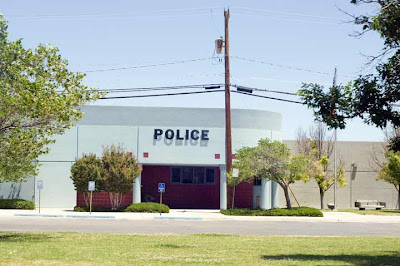 This is the Phil Chacon Memorial Southeast Area Command Sub-Station at 800 Louisiana, S.E., it was named after the deceased officer.
This is the Phil Chacon Memorial Southeast Area Command Sub-Station at 800 Louisiana, S.E., it was named after the deceased officer.Chacon was off-duty visiting a woman's shelter as part of his community services assignment, when two boys, living at the center, told him of an armed robbery at a shoe store across the street. Chacon was unarmed and riding his personal motorcycle, he gave chase to the suspects' car. Only a couple of blocks away, the car stopped, Chacon got off his motorcycle, and he was shot to death.
The investigation led by the homicide unit faltered. A parallel armed robbery investigation was more aggressive and split from the lead investigation. It might be termed that they went "rouge."
I was asked by a white-collar union official to assist in filing an administrative appeal for a civilian records clerk who was being disciplined for sharing information from a police report about her stepson with her husband. The stepson was providing questionable information to investigators while telling his father he had no problems with the law. The police report’s accounting (a public record) begged to differ with the son’s version about his character. Police administrators attempted to silence the records clerk to protect their flimsy criminal case.
The case was made more flimsy by the armed robbery detectives who were pursuing a "prime suspect.” They infiltrated a man, whom I had arrested on a felony fraud charge, as an informant next to their suspect.
The detectives traded away the signature fraud case of mine, and coerced their informant into cooperating.
The detectives never consulted me. Had they, I would have advised them the informant was legally useless because of the prior conviction for prior signature crime. Such a crime is the equivalent of perjury. Convicted perjurers may not testify except in their own defense; his use as a potential witness was worthless.
A State District Court jury convicted the prime suspect, Van Bering Robinson, of first-degree murder in Chacon’s death. The State Supreme Court reversed the conviction and a second trial resulted in an acquittal.
Robinson named the City, APD and the detectives in a civil action when he successfully sued for violation of his civil rights.
For havening conducted an “unauthorized investigation,” I received a two-day suspension and a 30-day assignment to Internal Affairs to “learn how the department ‘worked.’” I never served the assignment; the powers that be didn’t want me anywhere near IA. Though I would spend more than 30-days time in the Internal Affairs unit as a union representative for dozens of officers through the rest of my career.
 Three of the four armed robbery detectives went on to attain rank; one to sergeant, one to deputy chief of police, and another, Joe Polisar to chief of police, above.
Three of the four armed robbery detectives went on to attain rank; one to sergeant, one to deputy chief of police, and another, Joe Polisar to chief of police, above.Polisar, a native of New York rose as a "Golden Boy" through the department's ranks weathering some of the strongest political storms. In addition to the Chacon murder case, he was the commander of the intelligence unit that was involved in conducting investigations of political leaders and prominent citizens with no legal reason to believe they were involved in any criminal activity.
 Being married to the cousin of Mayor Martin J. Chávez, who appointed him chief, might not have mattered. Though Chávez said he had never met Polisar before interviewing him for the job of Chief; the statement was about the only surprising thing. Had Chávez admitted the nepotism, the 18 other documented relatives, through blood or marriage, in the police department, might not have laughed so hard. Polisar's wife, Liz Chávez, above, was also a mid-level manager for the City of Albuquerque. She is seen here supporting her husband during a difficult meeting of the Public Safety Advisory Board during his reading a lawyer prepared report about a number of recent police involved fatal shootings and resulting changes to the department's use of force policy.
Being married to the cousin of Mayor Martin J. Chávez, who appointed him chief, might not have mattered. Though Chávez said he had never met Polisar before interviewing him for the job of Chief; the statement was about the only surprising thing. Had Chávez admitted the nepotism, the 18 other documented relatives, through blood or marriage, in the police department, might not have laughed so hard. Polisar's wife, Liz Chávez, above, was also a mid-level manager for the City of Albuquerque. She is seen here supporting her husband during a difficult meeting of the Public Safety Advisory Board during his reading a lawyer prepared report about a number of recent police involved fatal shootings and resulting changes to the department's use of force policy.
 Scarantino, right, makes an assertion that Denish did no investigation; it might be based on his own biased definition that an investigative case must come from a law enforcement agency containing: police reports, statements, transcripts of interrogations, diagrams, medical records, crime scene photographs, and other forms of evidence, scientific laboratory reports, fingerprints, mug shots, arrest records of suspects, and the like.
Scarantino, right, makes an assertion that Denish did no investigation; it might be based on his own biased definition that an investigative case must come from a law enforcement agency containing: police reports, statements, transcripts of interrogations, diagrams, medical records, crime scene photographs, and other forms of evidence, scientific laboratory reports, fingerprints, mug shots, arrest records of suspects, and the like.Scarantino filed an inspection of public records request, wanting to see the investigative documents Denish produced. Denish made no record, but that doesn't mean she hadn't investigated.
There is an old axiom about lawyers:
when the evidence is against you, pound the law,There is information available to bolster Scarantino’s claim that the Denish ad, specifically William’s use of the word “investigated”, and the campaign’s choice in keeping the word in the ad, endorsing its sentiment as a fact.
when the law is against you, pound the evidence,
when the law and the evidence are against you, pound the table.
 Scarantino, among others (Denish, below, included) is a thief; he steals my photographs to enhance his postings.
Scarantino, among others (Denish, below, included) is a thief; he steals my photographs to enhance his postings. Denish reported receiving, "$10,000 each from Emily's List, a national political action committee that helps female Democratic candidates...."
Denish reported receiving, "$10,000 each from Emily's List, a national political action committee that helps female Democratic candidates...."However, on January 14, 2010, in a more in depth accounting, the The New Mexican's Steve Terrell posted:
Denish's largest contributor on this report was Emily's List, a national political action committee that supports female Democratic candidates who favor abortion rights. The PAC gave Denish two contributions totaling $55,000. Earlier in 2009, Denish reported another $10,000 from Emily's List, meaning the total is at least $65,000. In 2008, the PAC raised $43 million for its candidates.My photo of Denish appeared on Emily's List page for the Lt Gov. When I sent a bill to EMILY's List, their lawyer, in a response only another attorney might be gullible enough to accept, wrote:
First and foremost, EMILY’s List respects the intellectual property rights of others.Clearly if EMILY’s List does not respect intellectual property rights, or they wouldn't have felt compelled to write a letter. And removing a picture from a site after its use can demonstrate an impact does not resolve anything.
Without admitting any wrongdoing, our client has removed the Photo from its site at www.emilyslist.org, and appreciates you bringing this matter to our attention.
We assume that this action will resolve this matter. EMILY’s List was not aware of your claimed rights in the Photo, which was posted for a brief period of time and was used only in the context of our clients nonprofit charter. For all these reasons, we believe our client’s removal of the Photo should resolve this matter.
I would have licensed the Denish campaign use of the picture for a reasonable fee, because it was not being used in a negative ad. However, instead of contacting me after EMILY’s List had the picture removed, they have simply ignored me.
There is such an irony attached to this picture. The State Republican party produced an attack ad against Denish last year using my picture. When contacted, the GOP said they didn't think it was my picture because they located it on EMILY’s List and thought it was a Denish campaign owned picture. The GOP paid their bill.
 State Representative Janice Arnold-Jones R – Bernalillo County, introduced legislation House Bill 997, on February 7, 2007, to repeal the regional housing law. The duties and authority of the Regional Housing Authorities would have shifted to the New Mexico Mortgage Finance Authority.
State Representative Janice Arnold-Jones R – Bernalillo County, introduced legislation House Bill 997, on February 7, 2007, to repeal the regional housing law. The duties and authority of the Regional Housing Authorities would have shifted to the New Mexico Mortgage Finance Authority.The Health and Government Affairs Committee unanimously passed the bill with a minor amendment on February 22. It then went to the Business and Industry Committee where it passed, then the bill was postponed indefinitely; the bill never made it to the scheduled Appropriations and Finance committee and died at the end of the session.
Arnold-Jones is a member of the interim committees: Mortgage Finance Authority Act Oversight, she is also an advisory member of the New Mexico Finance Authority Oversight Committee.
 Arnold-Jones abandoned her chair in the House to run in the GOP primary for governor finishing last in a five-person race. The five candidates were: Pete Domenici Jr., Allen Weh, Arnold-Jones, Doug Turner, and Susana Martinez. Arnold-Jones will be replaced when a newly elected legislator, Conrad James, who faced no primary opponent and Democrats fielded no rival candidate.
Arnold-Jones abandoned her chair in the House to run in the GOP primary for governor finishing last in a five-person race. The five candidates were: Pete Domenici Jr., Allen Weh, Arnold-Jones, Doug Turner, and Susana Martinez. Arnold-Jones will be replaced when a newly elected legislator, Conrad James, who faced no primary opponent and Democrats fielded no rival candidate.As a matter of full disclosure, I provided access to my photographs, archives and video to Arnold-Jones during her primary campaign.
 Senator Mary Kay Papen (D) Dona Ana County also introduced legislation, Senate Bill 519, on January 24, 2007.
Senator Mary Kay Papen (D) Dona Ana County also introduced legislation, Senate Bill 519, on January 24, 2007.Papen’s bill, SB 519 passed the Senate, 36-1, and the House, 64-0.
Papen is a member of the Senate Finance committee, among others. She is also a member of several interim committees: the New Mexico Finance Authority Oversight committee, of which she is the Chair, and the Legislative Finance committee and is an advisory member of the Investments Oversight committees.
 Arnold-Jones said at a public meeting that she and Papen were in communication as they put together their individual legislation for each house. Though they were not mirror bills, as Arnold-Jones legislation stalled, Papen incorporated portions of the House Bill. Denish did not become involved with Papen’s bill until late in the legislative process, Arnold-Jones said.
Arnold-Jones said at a public meeting that she and Papen were in communication as they put together their individual legislation for each house. Though they were not mirror bills, as Arnold-Jones legislation stalled, Papen incorporated portions of the House Bill. Denish did not become involved with Papen’s bill until late in the legislative process, Arnold-Jones said.Denish signed the piece of legislation as the acting governor.
The bill was signed March 28, by Denish. “Governor Bill Richardson applauds today’s signing of Senate Bill 519 Regional Housing Authority Reform, by Lt. Governor Diane Denish,” a press release stated. “I’d also like to acknowledge Lt. Governor Denish who pushed tirelessly for this bill.”

 On the other side of the political divide, The Denish campaign released its first post Republican primary attack ad claiming two things: that GOP gubernatorial candidate Dona Ana County District Attorney Susana Martinez, left, has the worst homicide conviction rate of all DA’s in the state, and that when Martinez ran for DA, she had promised “We will not plea bargain a DWI case,” according to a September 5, 2004, Las Cruces Sun-News headline.
On the other side of the political divide, The Denish campaign released its first post Republican primary attack ad claiming two things: that GOP gubernatorial candidate Dona Ana County District Attorney Susana Martinez, left, has the worst homicide conviction rate of all DA’s in the state, and that when Martinez ran for DA, she had promised “We will not plea bargain a DWI case,” according to a September 5, 2004, Las Cruces Sun-News headline.The first part of the ad, Martinez’ homicide conviction rate was rapidly challenged and apparently debunked to the point that the Denish campaign has removed it from her site.
Though in a June 07, 2010 press release entitled “Hypocrisy Alert,” the Denish campaign called out Martinez’ 800 plea bargained drunk driving cases.
According to a prominent New Mexico political commentator, “She had flatly said a couple of years ago she would not plea bargain felony DWI cases, but she did.” [Blog, New Mexico Politics with Joe Monahan, 5/20/10] Martinez still has not explained why she broke this pledge.
The no plea bargain pledge just can’t be kept by a practicing district attorney, in this age of constrained governmental resources and time-limits imposed on prosecutors and the number of cases to be tried. It’s simply not pragmatic. Plea-bargaining is an indispensable part of the criminal justice system.
Sometimes the original charges filed by police are inflated or found by the district attorney’s office to be greater than the evidence eventually is capable of proving.
The reality of making a case in court, especially where records of prior convictions must: be located, verified, placed under seal, introduced, and into evidence, often times run into bureaucratic and jurisdictional nightmares. The element of how many prior DWI convictions must be proved and is routinely problematic. The number of arrests and even convictions found on a suspect’s rap sheet will not suffice for the court, under the rule of law, but is fertile ground for newspapers and candidates alike. Oft times the decision is to plea-bargain the case that can be made or lose the original charge for a lack of evidence. The public might not understand it, but the half a loaf is better than no loaf at all.
According to Las Cruces Sun-News headlines:
District attorney [Greg Valdez] will run for re-election (7/1/95)
Fired ADA [Susanna Martinez] awarded $122,000 (7/27/95)
According to Martinez' biography, in 1996 she defeated then DA Greg Valdez 59% - 41%.
In 2000 Martinez beat Kent Yalkut 51% - 49%
In 2004 Martinez beat Valdez again 60% - 40%
In 2008 Martinez was unopposed and got 100%
The parsing of a single word in political advertising comes off as an attempt to portray opponents in a negative light. The first blush may seem to indicate something that upon closer examination does not convey the same meaning.
 Final Thoughts
Final ThoughtsThere is the old saying that “politics make strange bedfellows.”
In New Mexico, “strange” would be a kind word.
 Nikolewski, interviewing the Senate Finance Committee Chair John Arthur Smith D – Hidalgo, Luna and Sierra Counties, is welcome. Rob jump in anyways, the water’s fine, if you can find any.
Nikolewski, interviewing the Senate Finance Committee Chair John Arthur Smith D – Hidalgo, Luna and Sierra Counties, is welcome. Rob jump in anyways, the water’s fine, if you can find any. For the fifth largest state, we only have about 250 square miles of surface water, and that considers one river, the Rio Grande, above, which, runs the length of the state, 440 miles, while a second, the Pecos, runs over 300 miles. The headwaters of the Pecos comes out of the aspen groves of the southern peaks of the Sangre de Cristo Mountains, east of Santa Fe and above the village of Pecos.
For the fifth largest state, we only have about 250 square miles of surface water, and that considers one river, the Rio Grande, above, which, runs the length of the state, 440 miles, while a second, the Pecos, runs over 300 miles. The headwaters of the Pecos comes out of the aspen groves of the southern peaks of the Sangre de Cristo Mountains, east of Santa Fe and above the village of Pecos. Water is more precious in New Mexico than the value of El Dorado or the seven golden cities of Cibola.
Water is more precious in New Mexico than the value of El Dorado or the seven golden cities of Cibola. New Mexico, where there is an unofficial autumn contest to see who can generate more hot air; the annual Albuquerque International Balloon Fiesta or our politicians during campaign season.
New Mexico, where there is an unofficial autumn contest to see who can generate more hot air; the annual Albuquerque International Balloon Fiesta or our politicians during campaign season.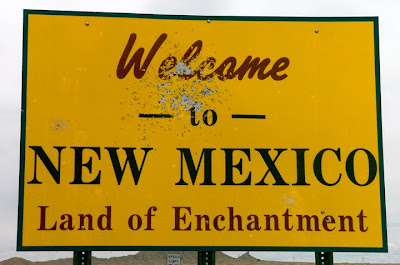 Yes, New Mexico welcomes almost everyone, you just aren't always made to feel that way.
Yes, New Mexico welcomes almost everyone, you just aren't always made to feel that way.